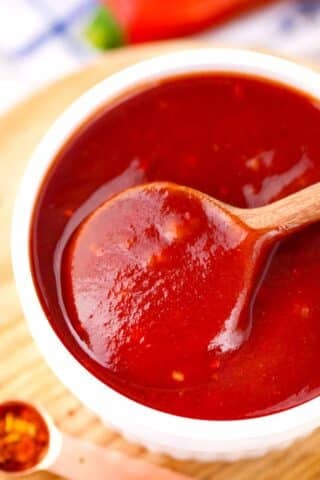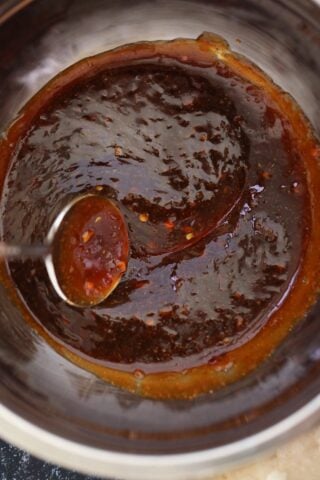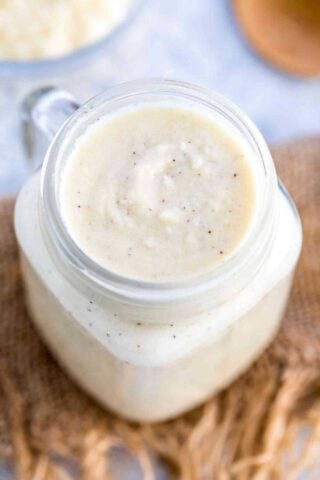Bearnaise Sauce
When I want to make a simple meal more elegant and special, I make this creamy Bearnaise Sauce. It’s especially delicious on fish, steak, and vegetables, and can take your poached egg sandwich to the next level. It takes just 20 minutes to make, and its that small detail that will make a big difference on the plate.

Whether I’m hosting a dinner party or eating to elevate my homemade dinner, this sauce never fails to impress. I pour it on everything; it makes roasted asparagus taste ten times better, and home-cooked, crispy tilapia tastes like a dish from a luxury restaurant. This delectable sauce tastes like pure indulgence, with the perfect balance of tanginess and citrus, making it ideal for a wide range of dishes.
Table of contents
While creamy sauces look intimidating, making it at home is incredibly easy. With just a few basic ingredients, like eggs, butter, vinegar, and herbs, I can make a silky smooth, rich, and flavorful sauce that instantly elevates any meal or side dish. Once you try your hand at making this recipe, you’ll feel like a chef who’s been let in on a secret kitchen hack. After you give it a try, just like me, you will want to pour it on everything.
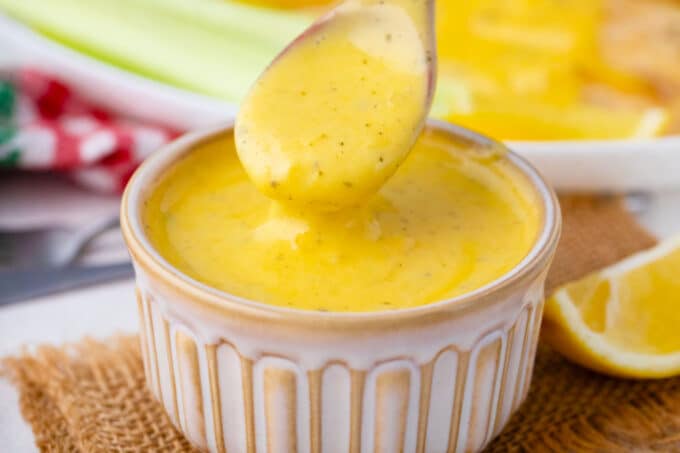
Why you will love this recipe
- It’s quick and easy: it takes just 15 minutes to make, with a few simple steps. Just follow the easy instructions.
- There are just a few ingredients: Just a handful of basic ingredients is all you need to make this sophisticated sauce.
- The elegant sauce is perfect for any dish: It can be paired with fish, beef, pork, chicken, or even vegetables. The mild flavor goes great with any entrée or side dish.
- Customize it to your needs: Do you like spicy sauce? Add some heat! Want more herbs? Toss in some thyme and basil.
What you will need
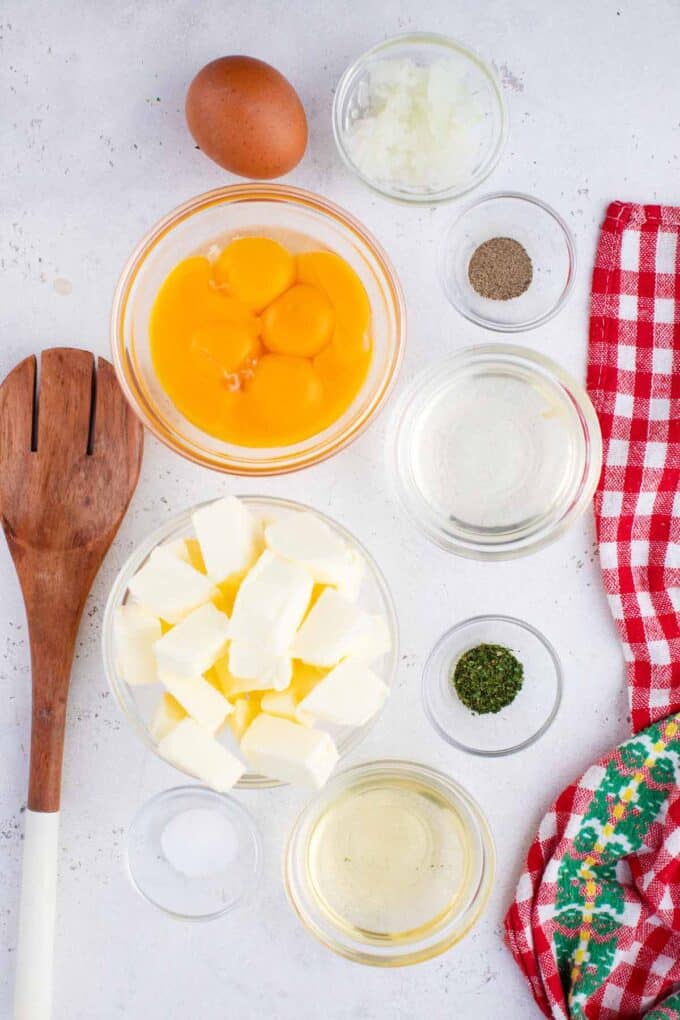
- Two white wines: I like to add both white wine vinegar and dry white wine to this sauce for their complementary hints and acidity. They create a slightly sweet and balanced flavor complexity.
- Flavor-enhancing: Minced shallots are a common ingredient in bearnaise sauce, distinguishing it from hollandaise sauce. The mild oniony taste has a little heat but not much bite. I also like to add minced garlic for its bold pungent flavor with a bit of sweetness.
- Spices: I use dried tarragon and lemon zest to enhance the sauce, adding a bright, fresh lemony flavor.
- Add the glue: The egg yolks are the most essential ingredients, providing the thickening power and glue to bind everything together, as well as richness to make the sauce creamy.
- Now the fat: Finally, I add the hot melted butter to ensure the emulsion. Clarified butter is the best choice and it should be added gradually so it doesn’t cause the sauce to curdle.
How to make
Mix the vinegar reduction: First, combine the vinegar, wine, garlic, shallots, tarragon, lemon zest, and salt and pepper to taste in a small saucepan. Let it come to a boil over medium-high heat. I continue to let it simmer, stirring with a wooden spoon, until it is reduced to about three tablespoons. Then, I strain the vinegar reduction into a large bowl and set it aside.
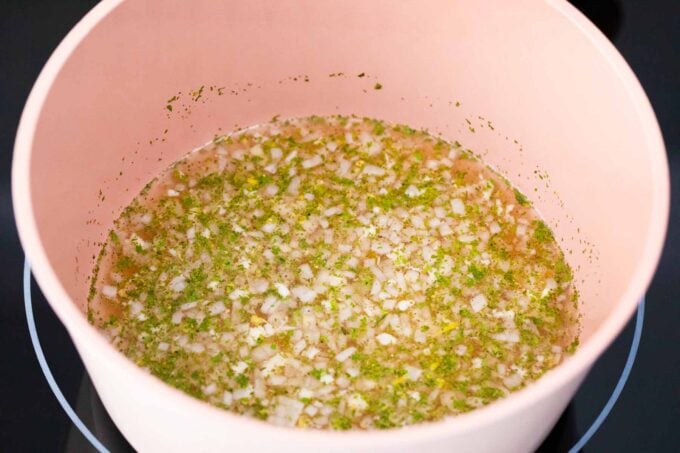
Whisk in the egg yolks: Now, I bring several inches of water to a boil in a saucepan over high heat and then let it simmer on medium-low heat. I whisk the egg yolks into the vinegar mixture and then place it over the pot of simmering water, whisking constantly until the yolks have thickened and turned a lemon yellow. Then, I remove the bowl and set it aside.
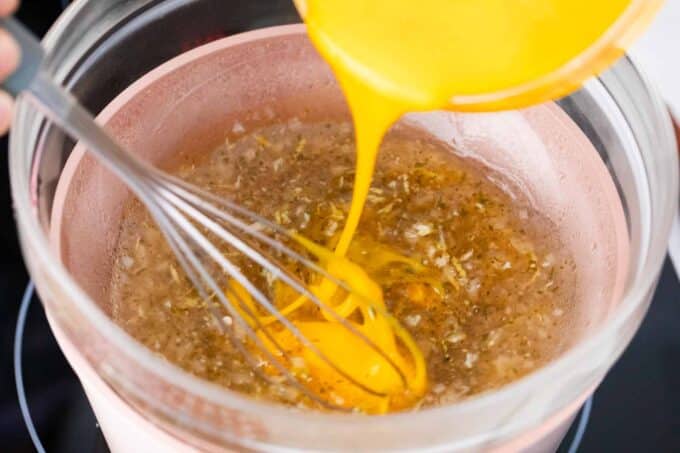
Whisk in the butter: I slowly pour the hot butter into the egg yolk mixture a little at a time, constantly whisking it vigorously. It has to be whisked the entire time while the eggs are being incorporated, so the sauce doesn’t separate.
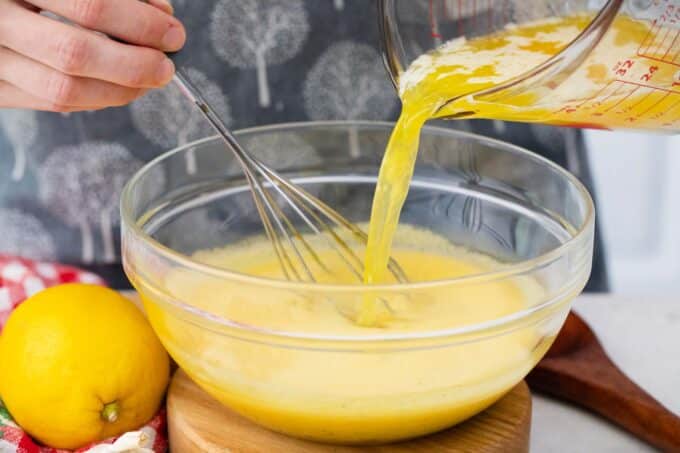
Serve: As soon as it’s mixed well, I serve it right away.
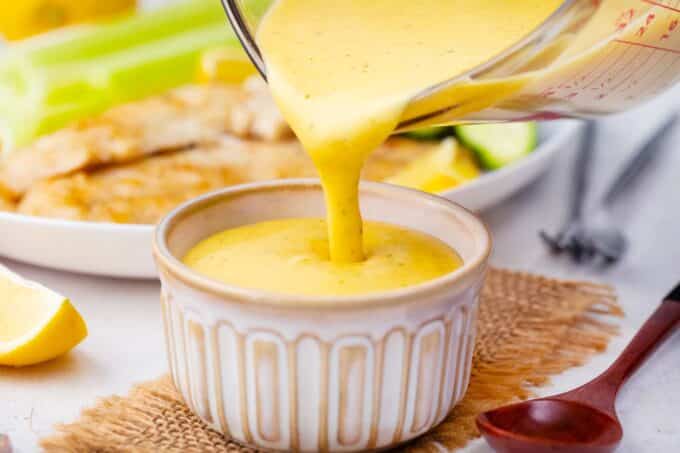
Expert tip
Controlling the heat
The most important thing to remember about bearnaise sauce is to control the heat. That means keeping it low and slow. Otherwise, it will separate and turn grainy or lumpy. Using direct heat when making this sauce is a definite no-no. The best idea is to use a double boiler or a heatproof bowl set over a simmering pot of water, as I do in this recipe.
The water needs to be at a gentle simmer when cooking the yolks, or you’ll end up with scrambled eggs instead of a smooth sauce. One thing I like about using a bowl over a pot of water is that I can remove the bowl from the pot if I feel it’s getting too hot. Patience is the key when making this sauce.
More tips to consider
- Use clarified butter to achieve an extra-smooth sauce.
- Add the butter slowly. Use a spoon and add one spoonful at a time, whisking as you go.
- If the sauce is separated, heat a fresh egg yolk in another bowl over simmering water and whisk the lumpy sauce into it.
- Be sure to serve it right away for the smoothest sauce and keep it warm until you’re ready to serve.
- Make sure the sauce is reduced before adding the egg yolks.
- Don’t skip the tarragon. This is what gives bearnaise its signature flavor.
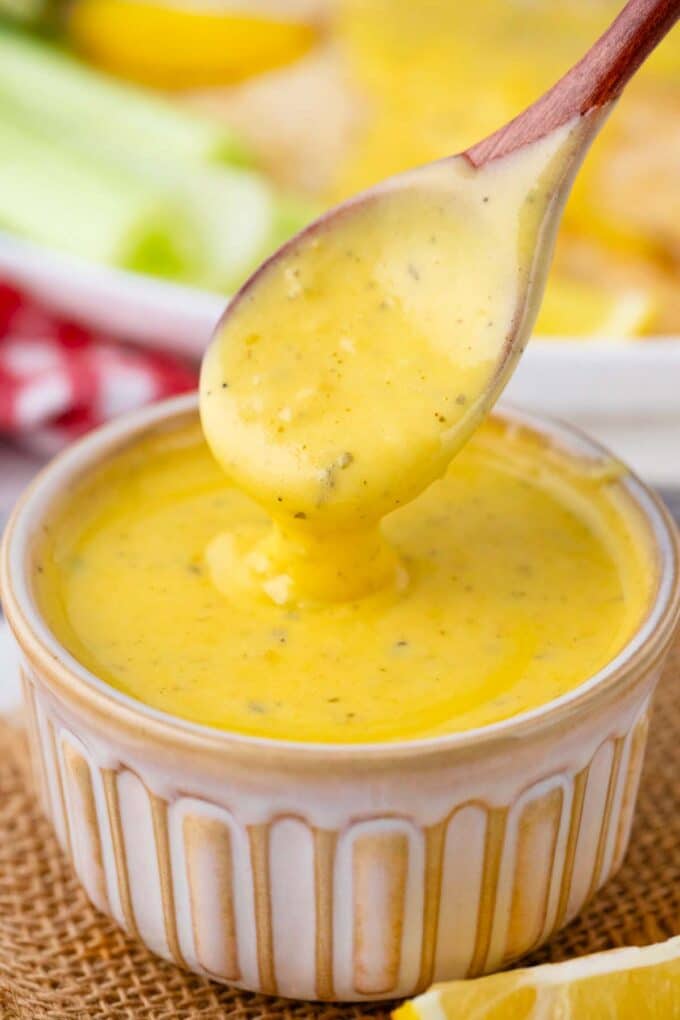
Recipe variations and add-ins:
- Orange bearnaise: With a ¼ teaspoon of orange zest added, the citrus flavor bursts out, but it’s not overwhelming.
- Spicy sauce: For spicy food enthusiasts, a pinch of red pepper flakes adds a kick to this sauce.
- Make it tangy: Adding a teaspoon of Dijon sauce to this sauce gives it a boost of incredible tanginess.
- Go green: Sometimes I like to add a ¼ cup of chopped spinach to not only enhance the flavor but also give it a beautiful green hue.
- Minty bearnaise: For some dishes, like my lamb pot roast, a minty-flavored bearnaise sauce is delicious, so I substitute the tarragon with mint.
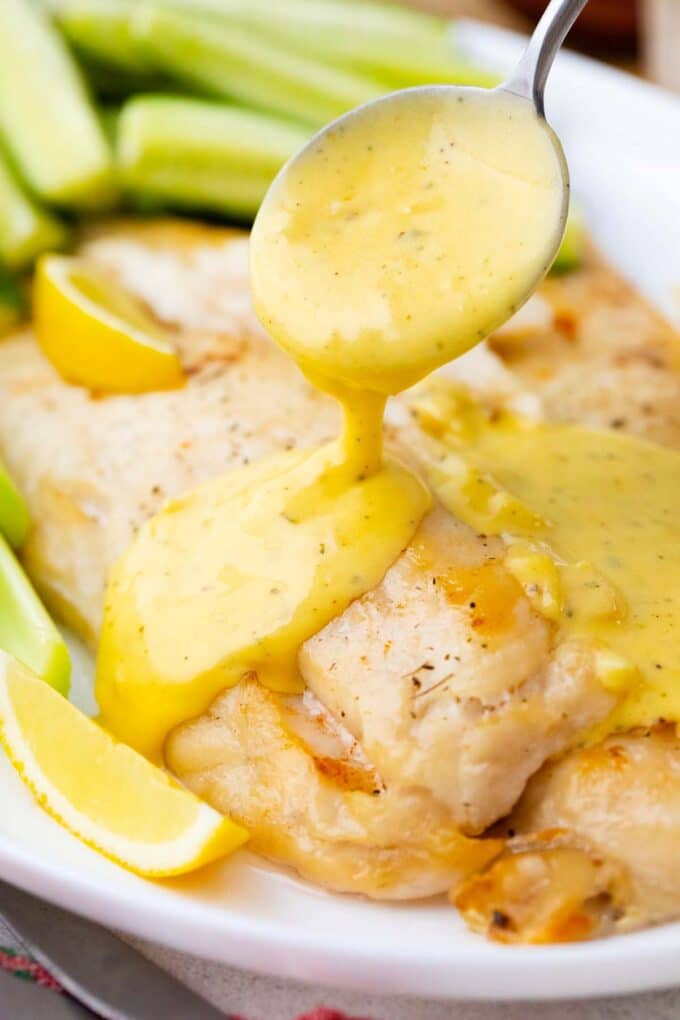
Serving suggestions:
This luscious, creamy sauce is perfect for my oven-roasted mahi-mahi recipe, which I can make in under 30 minutes. The smooth, rich flavor blends well with the mild flavor of the fillets as well as the tomatoes and asparagus on the side. Bearnaise sauce is also delicious on this crispy air fryer tilapia or this lemon garlic tilapia.
This sauce is also excellent on beef, like my air-fryer ribeye steak or juicy steak bites. As delectable as this sauce is, I like to use it on a wide range of things, from eggs to vegetables. I’ve used it on my crispy baked pork chops, and I’ve received rave reviews. I plan to try it again soon!
How to store leftovers:
- Refrigerate: Transfer the cooled sauce to an air-tight container and store it in the refrigerator for 1-2 days.
- Reheat: Do not microwave this sauce, it will cause the sauce to separate or crudle. Reheat it over low heat using a doible boiler. If it begins to separate, add a small amount of water or melted butter, to help emolsify it.
- Freeze: This is not a good sauce to freeze, it will separate and curdle.

Frequently asked questions
This usually happens because the vinegar, wine, and shallot mixture was not reduced enough before adding the egg yolks. It has to be simmered over medium-high heat until the liquid is reduced to about two tablespoons. Once the egg yolks are added, it’s too late to worry about reducing the sauce, so make sure it’s reduced before adding the eggs.
Bearnaise sauce curdles because high temperatures cause the proteins in the egg yolks to clump together, preventing emulsification. Adding the butter too quickly will overwhelm the emulsification and cause it to separate. Another reason the sauce can curdle is if there is too much acid in the ingredients. Measure carefully. Using low-fat ingredients is another common mistake. Fat is an essential ingredient.
Gentle heating. Follow my recipe, using a heat-safe bowl over simmering water. Whisk the egg yolk mixture while adding the butter a little at a time, to ensure the eggs do not overheat. Do not stop whisking until all the butter is fully incorporated or it will separate and become lumpy. Serve immediately while it is still thick and creamy. Adding ½ teaspoon of Dijon mustard can help stabilize the sauce and add a hint of tanginess.
If the sauce still has lumps, don’t panic. First, try adding another egg yolk. Sometimes just adding an extra egg yolk can help bring everything back together. Go back to the egg yolk step again and use a clean bowl, adding a fresh egg yolk. This will thicken the sauce nicely and smooth everything out. This can also be done faster and easier with just plain hot water, but the sauce will be runnier.
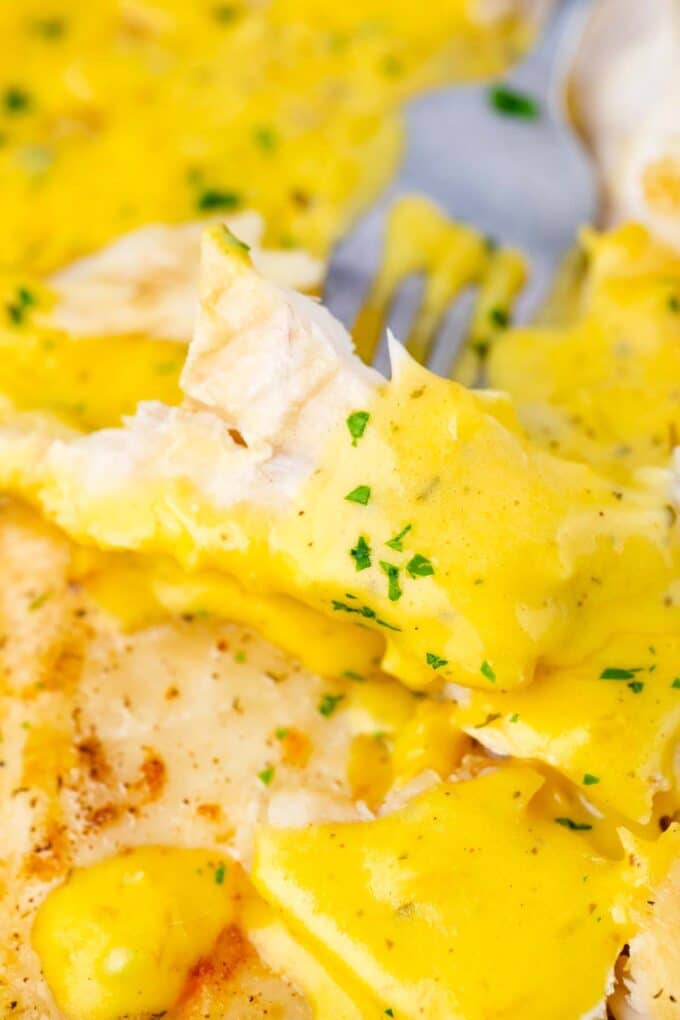
More sauces to try:
Loved this recipe? I’d love to hear from you! 💛 Leave a 5-star rating ⭐️ in the recipe card below and share your thoughts in the comments – I read and appreciate every single one!
Let’s stay connected! Follow me on Facebook, Instagram, Pinterest, and YouTube for more delicious, sweet and savory recipes. Have a question? Ask in the comments, and I’ll be happy to help! 😊 with love Catalina!
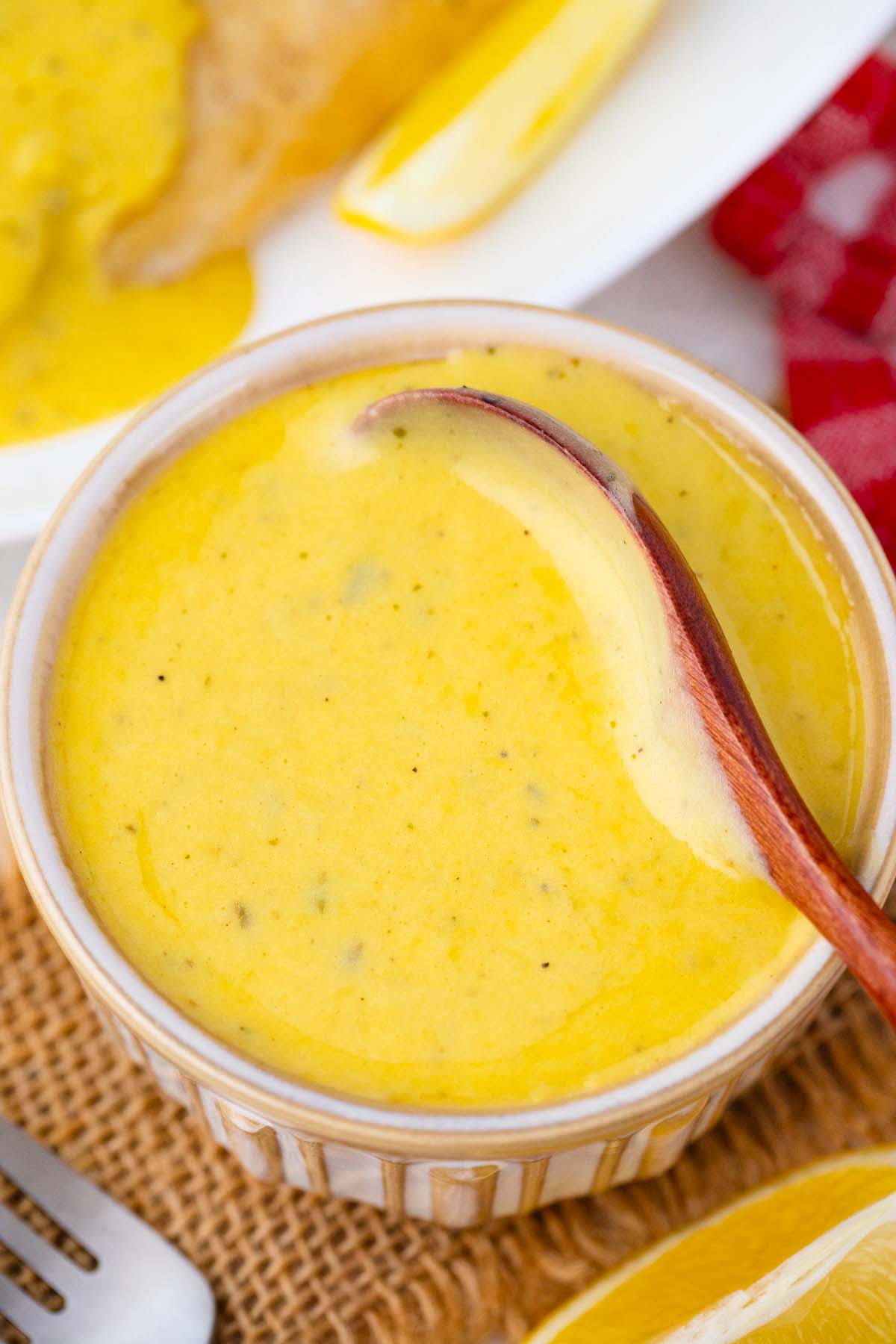
Bearnaise Sauce
Ingredients
- 1/4 cup white wine vinegar
- 1/4 cup dry white wine
- 1 tablespoon minced shallot
- 2 cloves garlic minced
- 1/2 teaspoon lemon zest
- 1/2 teaspoon dried tarragon
- 1/4 teaspoon salt
- pinch of ground black pepper
- 3 egg yolks whisked
- 1/2 cup hot melted butter unsalted
Instructions
- Combine the vinegar, wine, shallots, garlic, lemon zest, tarragon, salt, and pepper in a small saucepan. Bring the mixture to a boil over medium-high heat and continue boiling until the liquid has reduced to about 2-3 tablespoons.
- Strain the vinegar reduction into a large bowl and set it aside.
- Add about 1-1 1/2 cups of water to a sauce pan, and bring it to a boil over high heat. Reduce the heat to low, to maintain a simmer
- Bring several inches of water to a boil in a saucepan over high heat, then reduce the heat to low or medium-low to maintain a bare simmer. Place the vinegar mixture on top of the pot with the simmering water. The bowl should not touch the liquid.
- Very slowly and whisking constantly, add the egg yolks into the vinegar mixture. Whisk vigorously until the mixture thickened and turned a pale yellow color.
- Remove the egg yolk mixture from heat, and slowly pour the hot butter into it while continuing to whisk vigorously. Do not stop whisking until all of the butter is throughly incorporated into the sauce. The mixture should be smooth, thick and creamy. Serve immediately.
Notes
Controlling the heat
The most important thing to remember about bearnaise sauce is to control the heat. That means keeping it low and slow. Otherwise, it will separate and turn grainy or lumpy. Using direct heat when making this sauce is a definite no-no. The best idea is to use a double boiler or a heatproof bowl set over a simmering pot of water, as I do in this recipe. The water needs to be at a gentle simmer when cooking the yolks, or you’ll end up with scrambled eggs instead of a smooth sauce. One thing I like about using a bowl over a pot of water is that I can remove the bowl from the pot if I feel it’s getting too hot. Patience is the key when making this sauce.More tips to consider
- Use clarified butter to achieve an extra-smooth sauce.
- Add the butter slowly. Use a spoon and add one spoonful at a time, whisking as you go.
- If the sauce is separated, heat a fresh egg yolk in another bowl over simmering water and whisk the lumpy sauce into it.
- Be sure to serve it right away for the smoothest sauce and keep it warm until you’re ready to serve.
- Make sure the sauce is reduced before adding the egg yolks.
- Don’t skip the tarragon. This is what gives bearnaise its signature flavor.

